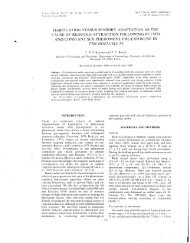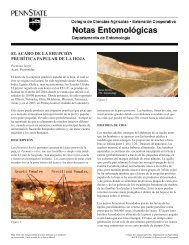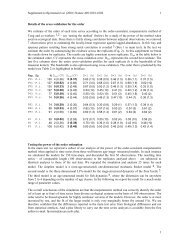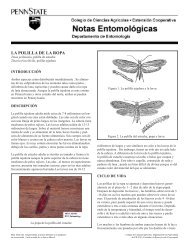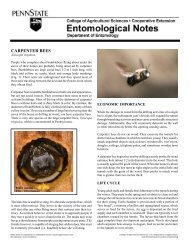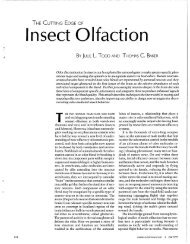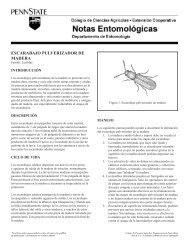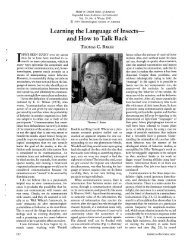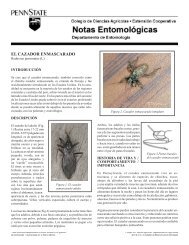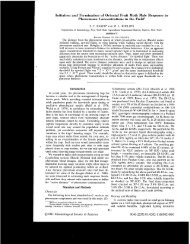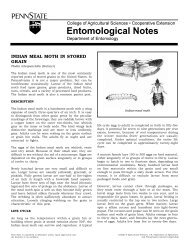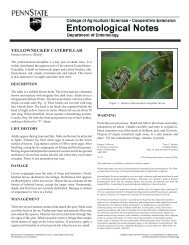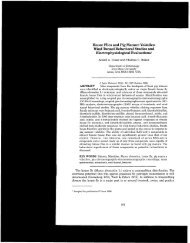Flour and Grain Mites - Entomology
Flour and Grain Mites - Entomology
Flour and Grain Mites - Entomology
Create successful ePaper yourself
Turn your PDF publications into a flip-book with our unique Google optimized e-Paper software.
College of Agricultural Sciences • Cooperative Extension<br />
Entomological Notes<br />
Department of <strong>Entomology</strong><br />
FLOUR OR GRAIN MITES<br />
The grain or flour mites are one of the most important<br />
mites infesting food <strong>and</strong> feed products, cereals, dried<br />
vegetable materials, cheese, corn <strong>and</strong> dried fruits.<br />
<strong>Grain</strong> mites proliferate under high moisture conditions<br />
<strong>and</strong> are often found in conjunction with fungal<br />
growth. Severe infestations result in brownish tinge<br />
over the commodity, called “mite dust” because of the<br />
light brown coloring of the mite legs. This “mite dust”<br />
gives off a “minty” odor if the mites are crushed. <strong>Grain</strong><br />
mites are widely distributed throughout the temperate<br />
regions, but only occur in tropical areas unless a<br />
constant influx of new mites is supplied via contaminated<br />
goods.<br />
DESCRIPTION<br />
<strong>Flour</strong> or grain mites are pale, pearly or grayish white,<br />
with legs varying in color from pale yellow to reddishbrown.<br />
Each leg has one claw at the end. As with all<br />
mites, they are smooth, wingless, soft-bodied creatures.<br />
The males are from 0.013 to 0.017 inch long, <strong>and</strong><br />
the female is from 0.014 to 0.026 inch. The males have<br />
enlarged forelegs which bear a thick spine on the<br />
ventral side. These two characters can be used to<br />
separate Acarus sp. from other genera. Juvenile mites<br />
are similar in appearance to the adults. The first or<br />
larval stage has only six legs. However, when they molt<br />
into the nymphal stage, they have eight legs like the<br />
adults. Mite eggs are oval, smooth, white, <strong>and</strong> are 0.12<br />
mm long.<br />
LIFE HISTORY<br />
Female grain mites may lay up to 800 eggs, which are<br />
deposited on the surface of food material at the rate of<br />
approximately twenty to thirty per day. The eggs may be<br />
deposited singly or scattered at r<strong>and</strong>om over the food<br />
material. The entire life cycle may take only nine to<br />
eleven days to complete under the optimal conditions<br />
of ninety percent humidity <strong>and</strong> seventy-seven degrees<br />
F. The life cycle is completed in seventeen days at<br />
sixty-four to seventy-one degrees F, <strong>and</strong> twenty-eight<br />
days at fifty to sixty degrees F.<br />
At some time during the juvenile period, grain mites<br />
may change into a stage known as the hypopus. During<br />
this unique stage, the body wall hardens <strong>and</strong> suckers<br />
appear on the underside. These suckers allow the mite<br />
to attach to insects <strong>and</strong> other animals for dispersal.<br />
The eggs <strong>and</strong> especially the hypopuses appear to be<br />
more tolerant of insecticides than other juveniles or<br />
adults; <strong>and</strong> they may be the primary stage responsible<br />
for resurgences in mite populations after chemical<br />
control appeared to have been successful.<br />
DAMAGE<br />
<strong>Grain</strong> mites primarily attack the germ. However, they<br />
will feed on other parts of the kernel, as well as mold<br />
growing on the grain. These mites are responsible for<br />
the spread of various fungal spores throughout a grain<br />
mass <strong>and</strong> into adjoining bins. When present in large<br />
numbers, the flour or grain mites promote sweating<br />
<strong>and</strong> impart a disagreeable odor to the grain. <strong>Grain</strong><br />
mites can cause “grocer’s itch” in humans exposed to<br />
the mites. Some persons may be allergic to mites.<br />
MANAGEMENT<br />
<strong>Flour</strong> or grain mite<br />
Prevention is the best strategy to avoid mite problems<br />
in stored grains. Proper bin sanitation before introduction<br />
of new grain minimizes the need for pesticides.<br />
Good sanitation involves the removal of old grain <strong>and</strong><br />
dust in <strong>and</strong> around the grain bin. This includes removal<br />
of old grain from corners, floors, <strong>and</strong> walls <strong>and</strong><br />
grain that may have spilled on the exterior of the bin.<br />
Penn State is committed to affirmative action, equal opportunity <strong>and</strong><br />
the diversity of its workforce.<br />
College of Agricultural Sciences, U.S. Department of Agriculture,<br />
<strong>and</strong> Pennsylvania Counties Cooperating
Any grain remaining when a bin is emptied can harbor<br />
insect infestations which will move into the new grain.<br />
After the bin is cleaned, <strong>and</strong> all needed repairs have<br />
been made, the floor <strong>and</strong> wall surfaces both inside <strong>and</strong><br />
outside the bin should be treated. Take special care to<br />
treat all cracks, crevices, <strong>and</strong> areas around doorways<br />
<strong>and</strong> other places where insects hide or enter. Spray the<br />
bins about four to six weeks prior to storing grain if the<br />
grain is to be stored longer than six months.<br />
Before grain is placed in a bin it should be screened to<br />
eliminate fine materials <strong>and</strong> broken kernels. <strong>Grain</strong><br />
placed in a clean bin should be checked at two week<br />
intervals during warm months <strong>and</strong> at one month<br />
intervals during cooler months for the presence of<br />
hotspots, moldy areas, <strong>and</strong> mite activity. If any of these<br />
conditions exist, the grain should be aerated to lower<br />
the moisture level <strong>and</strong> temperature.<br />
Issued in furtherance of Cooperative Extension Works, Acts of Congress May 8 <strong>and</strong> June<br />
30, 1914, in cooperation with the U.S. Department of Agriculture <strong>and</strong> the Pennsylvania<br />
Legislature. T.R. Alter, Director of Cooperative Extension, The Pennsylvania State<br />
University.<br />
The Pennsylvania State University is committed to the policy that all persons shall have<br />
equal access to programs, facilities, admission, <strong>and</strong> employment without regard to<br />
personal characteristics not related to ability, performance, or qualifications as<br />
determined by University policy or by state or federal authorities. It is the policy of the<br />
University to maintain an academic <strong>and</strong> work environment free of discrimination, including<br />
harassment. The Pennsylvania State University prohibits discrimination <strong>and</strong> harassment<br />
against any person because of age, ancestry, color, disability or h<strong>and</strong>icap, national origin,<br />
race, religious creed, sex, sexual orientation, or veteran status. Discrimination or<br />
harassment against faculty, staff, or students will not be tolerated at The Pennsylvania<br />
State University. Direct all inquiries regarding the nondiscrimination policy to the<br />
Affirmative Action Director, The Pennsylvania State University, 201 Willard Building,<br />
University Park, PA 16802-2801, Tel 814-865-4700/V, 814-863-1150/TTY.<br />
At humidities less than fifty-five to sixty percent (commodity<br />
at twelve percent moisture content or less)<br />
grain mites can not survive. <strong>Grain</strong> that is to be stored<br />
for longer than six months may need a protective<br />
application of an approved insecticide. Treatments can<br />
be applied as the grain is loaded into the bin through<br />
the use of a metering device calibrated to apply the<br />
proper amounts. After the grain is binned <strong>and</strong> leveled,<br />
a surface dressing can be applied to prevent insects<br />
from entering the grain on the surface.<br />
If infestation occurs in spite of these precautions,<br />
fumigation of the grain will be necessary. Because of<br />
the higher tolerance of mite eggs to fumigation, the<br />
concentration of gas introduced will need to be fifty<br />
percent greater than that for insect control. Fumigants<br />
are highly toxic, <strong>and</strong> technical knowledge is required<br />
for their proper use. A qualified, licensed pesticide<br />
applicator should be contacted to perform the fumigation.<br />
WARNING<br />
Pesticides are poisonous. Read <strong>and</strong> follow directions<br />
<strong>and</strong> safety precautions on labels. H<strong>and</strong>le carefully <strong>and</strong><br />
store in original labeled containers out of the reach of<br />
children, pets, <strong>and</strong> livestock. Dispose of empty containers<br />
right away, in a safe manner <strong>and</strong> place. Do not<br />
contaminate forage, streams, or ponds.<br />
Steven B. Jacobs<br />
Dennis Calvin<br />
Sr. Extension Associate Assistant Professor<br />
Dept. of <strong>Entomology</strong> Dept. of <strong>Entomology</strong><br />
October 1988<br />
SG-6 ã The Pennsylvania State University 2001<br />
This publication is available in alternative media on request.<br />
Where trade names are used, no discrimination is intended <strong>and</strong> no endorsement by The<br />
Pennsylvania State University or Pennsylvania Department of Agriculture is implied.<br />
Entomological Notes are intended to serve as a quick reference guide <strong>and</strong> should not be<br />
used as a substitute for product label information. Although every attempt is made to<br />
produce Entomological Notes that are complete, timely, <strong>and</strong> accurate, the pesticide user<br />
bears the responsibility of consulting the pesticide label <strong>and</strong> adhering to those directions.



